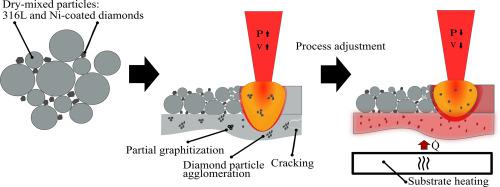当前位置:
X-MOL 学术
›
Diam. Relat. Mater.
›
论文详情
Our official English website, www.x-mol.net, welcomes your
feedback! (Note: you will need to create a separate account there.)
Diamond-impregnated 316L metal matrix composites fabricated by powder bed fusion with laser beam - Influences of the energy input on the microstructural properties
Diamond and Related Materials ( IF 4.3 ) Pub Date : 2020-11-01 , DOI: 10.1016/j.diamond.2020.108040 Jan Wegner , Alexander Fehr , Sebastian Platt , Stefan Kleszczynski , Gerd Witt , Wolfgang Tillmann
Diamond and Related Materials ( IF 4.3 ) Pub Date : 2020-11-01 , DOI: 10.1016/j.diamond.2020.108040 Jan Wegner , Alexander Fehr , Sebastian Platt , Stefan Kleszczynski , Gerd Witt , Wolfgang Tillmann

|
Abstract Fabricating diamond metal matrix composites (DMMCs) by means of powder bed fusion of metals using a laser beam (PBF-LB/M) is a new approach to extensively expand the spectrum of geometrical freedom for diamond tools. However, it must be borne in mind that the temperature input has a significant influence on the diamond condition since graphitizations are likely to occur. Therefore, it was analyzed how varying volume energy densities and substrate heating affect the microstructure and the densification of a 316 L stainless steel matrix, which was impregnated with 5 vol.-% Ni-coated diamonds. With regard to the densification, it was shown that an elevated substrate temperature (473 K) allowed to apply reduced volume energy densities and reduce stress-induced cracking. Thus, a relative density of 99.5% could be achieved. Furthermore, decreasing the volume energy density avoided graphitizations of the diamonds. Cr and Fe contents of the matrix material dissolved at the Ni-coated diamond surface revealing a diamond-metal interaction. A longer heat flux generally supported these diffusion processes at the interfaces. Finally, it became obvious that increased laser powers resulted in a higher densification, while low scan speeds and laser powers are desirable to foster diffusion and to avoid graphitizations.
中文翻译:

激光束粉末床融合制备的金刚石浸渍 316L 金属基复合材料 - 能量输入对微观结构性能的影响
摘要 通过使用激光束 (PBF-LB/M) 对金属进行粉末床融合来制造金刚石金属基复合材料 (DMMC) 是一种广泛扩展金刚石工具几何自由度范围的新方法。然而,必须牢记输入温度对金刚石状态有显着影响,因为很可能会发生石墨化。因此,分析了不同的体积能量密度和基材加热如何影响 316 L 不锈钢基体的微观结构和致密化,该基体浸渍有 5 vol.-% 镀镍金刚石。关于致密化,表明升高的基板温度 (473 K) 允许应用降低的体积能量密度并减少应力引起的开裂。因此,可以实现 99.5% 的相对密度。此外,降低体积能量密度避免了金刚石的石墨化。基体材料中的 Cr 和 Fe 含量溶解在镀镍的金刚石表面,揭示了金刚石-金属的相互作用。较长的热通量通常支持这些界面处的扩散过程。最后,很明显,增加的激光功率会导致更高的致密化,而低扫描速度和激光功率对于促进扩散和避免石墨化是可取的。
更新日期:2020-11-01
中文翻译:

激光束粉末床融合制备的金刚石浸渍 316L 金属基复合材料 - 能量输入对微观结构性能的影响
摘要 通过使用激光束 (PBF-LB/M) 对金属进行粉末床融合来制造金刚石金属基复合材料 (DMMC) 是一种广泛扩展金刚石工具几何自由度范围的新方法。然而,必须牢记输入温度对金刚石状态有显着影响,因为很可能会发生石墨化。因此,分析了不同的体积能量密度和基材加热如何影响 316 L 不锈钢基体的微观结构和致密化,该基体浸渍有 5 vol.-% 镀镍金刚石。关于致密化,表明升高的基板温度 (473 K) 允许应用降低的体积能量密度并减少应力引起的开裂。因此,可以实现 99.5% 的相对密度。此外,降低体积能量密度避免了金刚石的石墨化。基体材料中的 Cr 和 Fe 含量溶解在镀镍的金刚石表面,揭示了金刚石-金属的相互作用。较长的热通量通常支持这些界面处的扩散过程。最后,很明显,增加的激光功率会导致更高的致密化,而低扫描速度和激光功率对于促进扩散和避免石墨化是可取的。









































 京公网安备 11010802027423号
京公网安备 11010802027423号